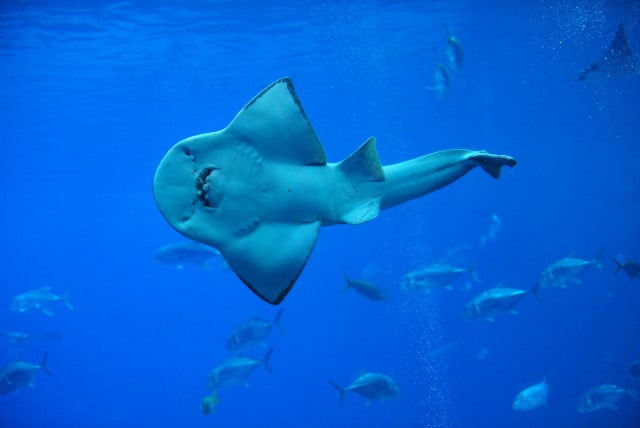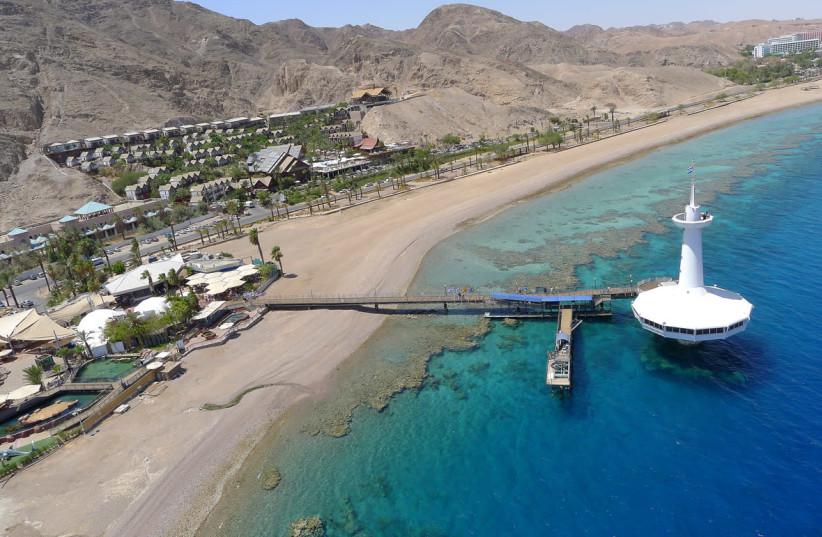Underwater robot spots guitarfish in Eilat, Israel

An underwater robot sent by Israeli researchers to the depths of the sea of the Gulf of Eilat recently discovered a guitarfish.
A guitarfish was spotted some 80 meters below the waves during surveys conducted by the Nature and Parks Authority, Tel Aviv University and an underwater robot by the Beacon company on the coast of Eilat.
"Guitarfish are from the cartilaginous fish family [like sharks]," said Nature and Parks Authority marine ecologist Dr. Assaf Zebuloni. "They get their name because of their body structure, which resembles a guitar – an elongated body with a wide front and a shark-like back. The body's colors and shape are adapted to the sandy bottom of the sea, where they search for food like mollusks, crabs, worms and other bottom feeders."
Guitarfish live in tropical and subtropical environments in sandy areas, so it's important to preserve these soft sea floors. This research effort supports the Nature and Parks Authority's initiative to protect these deeper and unfamiliar areas of the sea, home to animals like guitarfish.
"A privilege reserved for explorers"
"Very few people today get to visit the pristine places not yet seen by man until now," Zebuloni said.
"This is a privilege reserved mainly for explorers, mountain climbers, daring hikers and astronauts. Despite the many marine studies that have been done, humans visually know the marine environment in a very superficial way, specifically the shallow areas. Most divers reach this depth (around 30 meters) and very few go deeper. Submarines let people reach very impressive depths, but the cost to purchase one and operate it is very high. But underwater robots are becoming more and more available, which will allow researchers to send cameras and sampling equipment to parts of the deep sea that have yet to be observed and studied.
"In Eilat, because of the steep slope characterizing the geological fault in the Dead Sea Rift, the deep areas are very close, just a few hundred meters from the shoreline. Even though they're so close, we hardly know anything about them because reaching these depths isn't easy."
The personal experience
"As part of my work as an ecologist... I was lucky enough to explore the deep areas of the Gulf of Eilat," Zebuloni added.
"The Nature and Parks Authority invests a lot of effort in reviewing and monitoring the marine environment, including the areas that are hard to reach, because they can have a lot of ecological importance. Since 2021, I've had the chance to lead dozens of research trips where we sent an underwater robot [ROV - Remotely operated Vehicle] with the goal of photographing the Mesophotic areas along the coast of Eilat. Some light still reaches these areas but not a lot, and there has only been low-intensity study there by researchers. Our main goal was to study them, classify them ecologically and map them.
"The need for maps came about after we found the ecological value and decided we needed to protect these areas as marine nature reserves. Despite my years of familiarity with the marine environment of Eilat, I will admit that every time I lower the ROV into the depths of the sea, I get excited all over again. The ROV transmits a live broadcast of what it's photographing, and it can be said that to some extent, I'm like an astronaut landing on the Moon. On the way to the deep sea, the light slowly fades and at some point, we need to turn on the ROV's lights to see things. Getting to the bottom always sparks excitement and curiosity – will we find reefs or a sandy sea floor?"
Jerusalem Post Store
`; document.getElementById("linkPremium").innerHTML = cont; var divWithLink = document.getElementById("premium-link"); if (divWithLink !== null && divWithLink !== 'undefined') { divWithLink.style.border = "solid 1px #cb0f3e"; divWithLink.style.textAlign = "center"; divWithLink.style.marginBottom = "15px"; divWithLink.style.marginTop = "15px"; divWithLink.style.width = "100%"; divWithLink.style.backgroundColor = "#122952"; divWithLink.style.color = "#ffffff"; divWithLink.style.lineHeight = "1.5"; } } (function (v, i) { });

